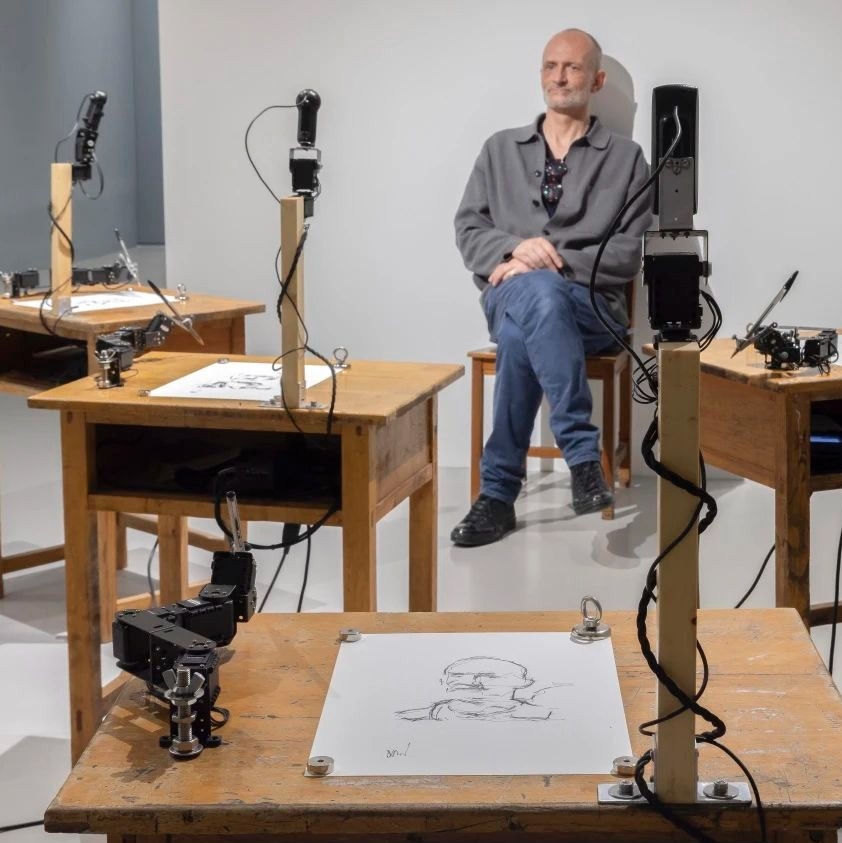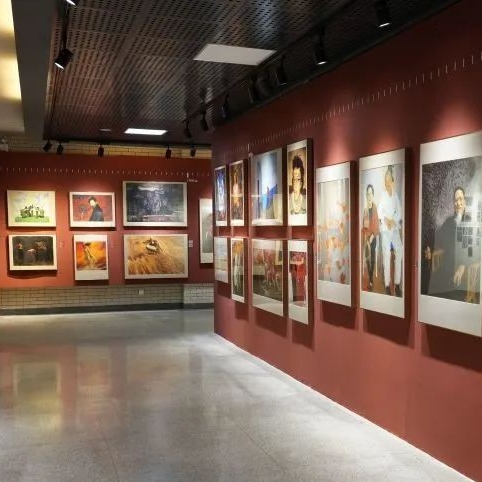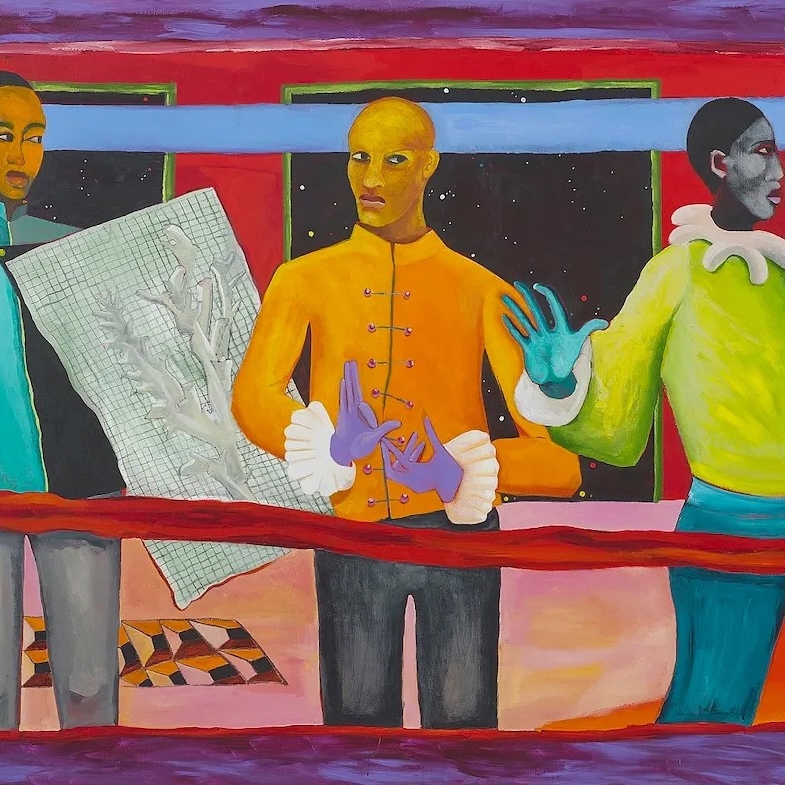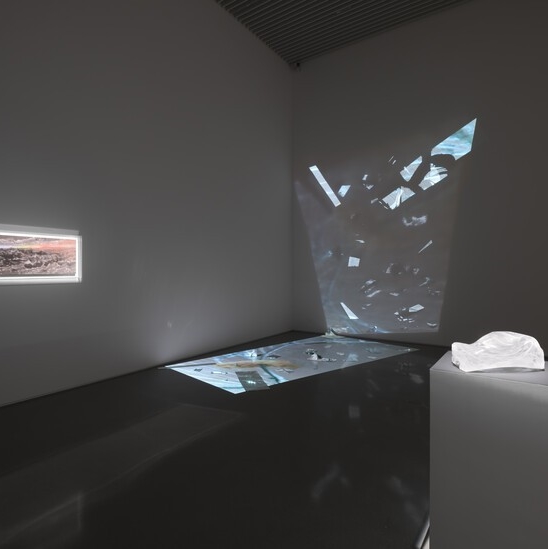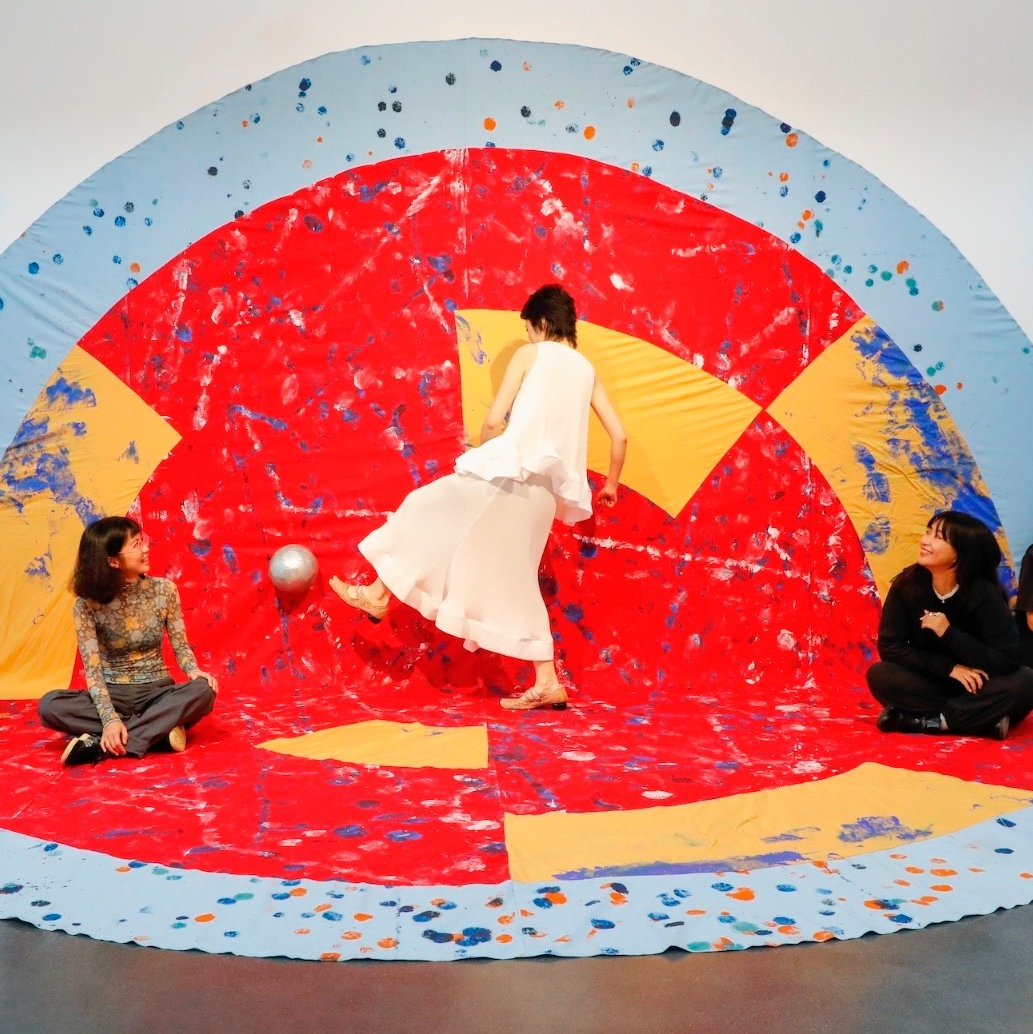
Fou Gallery presents Crafting the Past from the Future, which features thirty-five works of art from the early twentieth century to the contemporary era. This selection of artworks allows visitors to travel through time and to recognize artists’ continuous effort in exploring the changing roles of crafts. This exhibition shows how artists or crafters held rich visions of the past and future, and how their artworks came out of these imaginings. It will remain on view until March 13, 2022.

Lin Yan, No. 989 202001#4, 2020. Xuan paper and ink on artist panel, 12 x 12 inches (30.5 x 30.5 cm), ©Lin Yan, courtesy of Fou Gallery
Sueharu Fukami, Vase, Ca. 198., Porcelain with seihakuji glaze, 8 x 8¾ x 8¾ inches (20.5 x 22 x 22 cm) ©Sueharu Fukami, courtesy of Fou Gallery
In our proto-metaversed world of work-from-home, AI art, and driverless cars, people are reconsidering what it means to “craft” something out of the physical materials that surround us. Although this exhibition features artists/crafters from China and Japan, their works reflect global debates about the contested concepts of craft and art. Some artists/crafters still regard the material approach as the base of craft, but they creatively manipulate materials to include personal or collective memories that deserve a discourse as elevated as that for art. Sueharu Fukami (b. 1947) chose the traditional Seihakuji (qingbai in Chinese) as his medium and incorporated the high-pressure slip casting technique in his art-creation process. He utilized elements such as samurai swords, wave shapes, and leaves to further his pursuit of perfection in color and form. For Meng Du (b. 1986), glass is a material that can carry humanist concerns. In her Everywhere Nowhere II series, pigeons, cast with glass and silver, sit on concrete columns or directly on the sand, with their heads filled with fake pearls. Inspired by her personal experience in the metropolitan area, the pigeons preserve the artist’s feelings of confusion and nostalgia at the time.

Meng Du, Everywhere, Nowhere II, 2019. Glass, multimedia, fabric, silver, each about 8.2x3.6x6.9inches, site-specific installation, ©Meng Du, courtesy of Fou Gallery and the Delaware Contemporary
Kyoko Ibe, Ten Chi Jin (Heaven Earth Human), 2013. Panel, recycled ganpi paper fiber, old documents, mica and sumi, 31 x 62½ inches (78.7 x 159 cm), ©Kyoko Ibe, courtesy of Fou Gallery
Some might see future crafts indistinguishable from art in that they address abstract ideas, including the crises and solutions of the world, or even have the ability to raise contentious political stakes. Kyoko Ibe (b. 1941) worked with washi, traditional Japanese hand-made paper, which to her embodies the traditional Japanese sense of oneness with nature. Her artworks respond to themes such as sustainability, as the recycling of washi gives new meaning to the old idea of kankonshi (“paper with its soul brought back to life"). Shuyi Cao (b. 1990) worked with multiple mediums. She employed alchemical approaches to art creation and knowledge production. Her Stone Will Call You Sporadic series emulates various landscapes and utilizes insect specimens to probe into how the Anthropocene fits into the history of the earth. Wanying Liang (b. 1989) mainly works with clay to create expressive sculptures. Her Woman as Vessel series not only shows the artist’s fascination with flowers and seeds, but also embeds her memories of her mother as well as her own experience as a mother, and connects crafts with discussions of feminism. Perhaps, there is no way to recover the distinction between craft and art.

Shuyi Cao, Alpine (7 Years Underground), 2021. Stoneware, glaze, oxides, cicada shed, 9 x 21 x 2 inches (22.86 x 53.34 x 5.08 cm), ©Shuyi Cao, courtesy of Fou Gallery  Isshū Saiuchi, Winter Landscape, 1940s. Two-panel folding screen, shell powder and ink on paper, 57½ x 70½ inches(146 x 179 cm), ©Isshū Saiuchi, courtesy of Fou Gallery
Isshū Saiuchi, Winter Landscape, 1940s. Two-panel folding screen, shell powder and ink on paper, 57½ x 70½ inches(146 x 179 cm), ©Isshū Saiuchi, courtesy of Fou Gallery
In contrast to the above-mentioned contemporary works, crafts from the last century may appear to be traditional and apolitical objects that focus on formal qualities. Nevertheless, in their time, those artists/craftsters were pioneers. They emphasized anti-modern, hand-made aesthetics and the much-ignored labor of craft making. As products of the Industrial Revolution, the arts and crafts movements started in England and quickly spread to other parts of the world, including East Asia. These intellectual movements led people to react against the desacralizing of material reality in mass-produced crafts. In this exhibition, Isshῡ Saiuchi’s (b. 1910) folding screen, Tomio Munemi’s bamboo baskets, and anonymous Japanese artists’ inros, writing boxes, and lacquer trays all demonstrate the artists’ love of their materials. Crafts stopped being only about labor, but more about dignity. This group of works highlights natural elements, simple design, and also sometimes the anonymity of the crafter.

Koma Yasutada, Karako Inro, 19th century. Maki-e gold lacquer on wood, 2½ x 2¾ inches (6.5 x 7.2 cm) ©Koma Yasutada, courtesy of Fou Gallery Liang Wanying, No. 1347 Woman As Vessel 03, 2021. Porcelain, 18 x 12 x 5 inches (45.72 x 30.48 x 12.7 cm), ©Liang Wanying, courtesy of Fou Gallery
Liang Wanying, No. 1347 Woman As Vessel 03, 2021. Porcelain, 18 x 12 x 5 inches (45.72 x 30.48 x 12.7 cm), ©Liang Wanying, courtesy of Fou Gallery
From folk art for the great mass of people to new technology or material-based crafts that are almost indistinguishable from fine arts, this exhibition examines how artists/crafters from different time periods have renewed the concept of craft. Their works can perhaps advise us how to retrieve beauty from our rapidly degrading physical world amidst unlimited digital revolution.
BIOGRAPHY - SELECTED ARTISTS
Cao Shuyi (b. 1990, Guangzhou, China) is a New York-based artist whose practice explores alchemical approaches to object making and knowledge production. She received a Bachelor of Laws from Fudan University in Shanghai (2013), M.A. in Public Administration from Fudan University (2016), M.F.A. from Parsons School of Design, New York (2018). Her work has been widely exhibited in the U.S.A. and China. Recent exhibitions include: Reshape, Today Art Museum, Beijing (2021); Do Not Black Out, Ming Contemporary Art Museum, Shanghai (2021); Let’s try listening again: 13th A.I.R. Biennial, A.I.R. Gallery, New York (2019); Site-specific installation for MASSMoca, North Adams, Massachusetts (2018). She is the recipient of many international awards, including Today Art Museum Wang Shikuo Nomination Award (Beijing, 2021), The New School Tishman Environment and Design Center Research Grant (New York, 2021), Hyundai Blue Prize 2020 finalist (Beijing, 2020), Community Outreach Grant, MASS MoCA’s Assets for Artists program (New York, 2018).
Meng Du (b.1986, Beijing, China) graduated from the Graphic Design program of Central Academy of Fine Arts, Beijing (B.F.A.) in 2008 and the Digital Art program at the Department of Glass Program of Rochester Institute of Technology (M.F.A.) in 2013. Currently, she is living and working in Beijing. Her work has continued to exhibit in China, Europe, and in the United States. Her recent exhibitions include: Finding Hidden Genius: Vivian Maier, Today Art Museum, Beijing (2021); Mind the Gap, The Delaware Contemporary, U.S.A. (2020); Meng Du: Embers, Fou Gallery, New York (2019); Meng Du: The Room, Shanghai Museum of Glass, Shanghai (2018). Du was invited to give lectures at YiXi (2020) and ROG International Art Project Online Symposium (2020). In 2016, she won the Honorable Mention for The International Exhibition of Glass Kanazawa (Kanazawa, Japan). In 2018, she won the 2018 Saxe Emerging Artist Award at 48th Glass Art Society Conference (Venice, Italy). She is the youngest artist who presented a solo exhibition at the Shanghai Museum of Glass.
Tsuji Hokuyosai II (1909–1999, Kagawa, Japan) is a well-known Maki-e lacquer artist from Japan. Tsuji Hokuyosai II first showed his work at national level in the special exhibition to celebrate the 2600th anniversary of the founding of the Empire of Japan, held in 1940. After World War II, he made a major contribution to lacquer art in his native Kagawa Prefecture. Most recently his work was featured in the Kagawa Maki-e Exhibition, Takamatsu City, Japan (2020).
Kyoko Ibe (b. 1941, Nagoya, Japan) has earned a reputation as one of Japan's leading artists with her large-scale installations of washi, or traditional Japanese paper. Ibe is now one of Japan's most senior and respected artists in the medium, creating site-specific installations and theater sets that can fill large architectural spaces, as well as more domestic-scale panels and folding screens fashioned out of dyed and pulped antique documents originally brushed with handwriting in sumi ink. Appointed by the Japanese Government as a Special Advisor for Cultural Exchange, Ibe has worked in many parts of the world as an international ambassador for washi. Her solo show Washi Tales: The Paper Art of Ibe Kyoko was held at the Los Angeles County Museum of Art in 2011. In 2016 Asia Society (New York) presented "Recycling: Washi Tales," a theatrical performance around four tales of paper making, in which Ibe's work played a prominent role. Ibe’s works are in the collection of many different museums all across the world, including Art Institute of Chicago (Chicago), Kyoto Institute of Technology Museum (Kyoto), Los Angeles County Museum (Los Angeles), Nelson-Atkins Museum of Art (Kansas City, U,S.A.), Nordjyllands Kunstmuseum (Aalborg, Denmark), and Utah Fine Art Museum (Salt Lake City, U.S.A.) among others.
Sekigawa Katsunobu (ca. 19th century, Japan) is thought to have worked in Edo period (1615–1868) , most often signing his inro with his family name Sekigawa followed by his personal name Katsunobu enclosed in an elaborate red-lacquer pot-shaped mark, suggesting that he was connected to the Kajikawa workshop, which is one of the major centers of fine lacquer production in the city of Edo from the 17th century.
Fukami Sueharu (b. 1947, Kyoto, Japan) is one of the most well-known Japanese ceramic artists. He currently works and lives in Kyoto, Japan. Born in 1947 to a Kyoto family that manufactured porcelain tableware, Sueharu Fukami was exposed an early age to a variety of ceramic styles and working methods, experimenting widely before he developed a unique practice that has earned him a global reputation both for technical mastery and for single-minded pursuit of perfection in form and finish. Fukami's artistic achievements have been recognized by a wide range of honors including the Grand Prize at the International Ceramic Exhibition at Faenza, Italy and two Gold Medals from the Japan Ceramics Society. Fukami’s works are in the collection of many different museums all across the world, including the Metropolitan Museum of Art (New York), Art Institute of Chicago (Chicago), Brooklyn Museum (New York), British Museum (London), Musée National de Céramique (Sèvres, France), National Museum of Modern Art (Tokyo), National Museum of Modern Art (Kyoto), National Museum of History (Taipei), Museum of Fine Art (Boston), and Victoria and Albert Museum (London).
Wanying Liang (b. 1989, Weinan, Shaanxi Province, China) is an artist who works with clay as the main medium to create expressive sculpture and installation. She received B.F.A. from China Central Academy of Fine Art in Beijing (2011). Before moving to America to study ceramics at Alfred University in 2016, Liang set up her studio in Jingdezhen to make art pieces and tableware. She currently lives and works in New York State. From 2018 to present, her works have been widely exhibited in the U.S.A., United Kingdom and China. Her recent exhibitions include: Blanc de Chine – Contemporary, The Scottish Gallery, Edinburgh (2020); Collect International Art Fair for Modern Craft and Design, Somerset House, London (2020); Blanc de Chine, A Continuous Conversation, V&A Museum, London (2019–2020); Contemporary Asian Ceramics Exchange Exhibition, Crafts Museum of China Academy of Arts, Hangzhou, China (2019).
Lin Yan (b. 1961, Beijing, China) Born in Beijing, China to a prestigious artists’ family, Lin has been greatly influenced by her art family since her childhood. As the third generation of the family, Lin Yan’s practice is deeply rooted in her family’s artistic spirit and develops her own independent artistic language. After graduating from The Central Academy of Fine Arts in 1984, Lin pursued further studies at L'École Nationale Supérieure des Beaux-Arts in Paris in 1985. Currently she lives and works in New York. In 2005, she began to use handmade Xuan paper as medium for creation. With the simplest Xuan paper and black and white ink, she creates a sense of weight and layering. Installations with architectural features and sculptures with the painterly characters expand her artistic language. Lin Yan has held solo or group exhibitions at important international institutions, including the Museum of Chinese in America (New York), The National Art Museum in China (Beijing), Minsheng Art Museum (Beijing), Today Art Museum (Beijing), the Dresden State Art Collection (Germany), He Xiangning Art Museum (Shenzhen), etc. Her works have been included in the permanent collections of public institutions, including Deutsche Bank Art Corporate Citizenship (New York), White Rabbit Gallery (Sydney), Chengdu Contemporary Art Museum, Long Museum (Shanghai), Pang Xunqin Museum (Changshu), National Museum of China (Beijing), Museum of Central Academy of Fine Arts (Beijing), etc.
Isshū Saiuchi (b. 1910, Tokyo, Japan) With a birth name as Kōzō, Isshū Saiuchi lived in Tokyo for most of his lifetime. He learned paintings from Yamamoto Shunkyo (1872–1933) and Yamaguchi Kayō (1899–1984) and mastered painting at Maruyama–Shijō School. He was first selected at Bunten Art Exhibition (Japan Fine Arts Exhibition) held in 1936 for the first time, and ever since consecutively won awards at a number of art exhibitions including Shinbunten Art Exhibition (4 and 5) as well as Nitten Art Exhibitions (1941, 1942, 1946, 1946, 1948, 1949, 1950). He also actively held his private exhibitions and became one of the leading artists during his time in the Kyoto art circle.
Arai Sōu (1890–1967, Ibaraki Prefecture, Japan) studied at a private academy in Kyoto and was also a disciple of Yokoyama Taikan, whose influence can be clearly seen in this composition of receding mountain ranges wrapped in clouds. In September 1937 he was one of a group of eight artists who broke away from the Meirō Bijutsu Renmei (founded in 1934) to form the Shin Kokuga Kyōkai.
BIOGRAPHY - CURATORS
Xiaorong Liu (b. 1995, Hangzhou, China) is a freelance writer, curator, and currently an Ishibashi Scholar at Tokyo University of the Arts. She graduated with a bachelor's degree in art history and math from Wellesley College, and obtained her master's degree from Yale University in East Asian Studies. She has assisted with the implementation of the Art and China after 1989 exhibition at the Guggenheim Museum (New York) and the Icons of New China photography exhibition at Yale-China (New Haven, Connecticut). She has also curated the inaugural online exhibition Legacies of Literati at Fou Gallery (New York) and led the Cafe China x Anne Muntges project (New York) supported by Art in Touch in 2021. As a freelance writer, she has written for CAFA ART INFO and has also worked as a Chinese editor for the Museum 2050 Looking to New Institutional Models conference essay anthology.
Echo He (b. 1986, Chengdu, China) is a curator, gallerist, millinery artist and writer in New York. She is Programming and Outreach Manager at Pace Gallery. In 2013, she founded and has continued to operate Fou Gallery, a unique gallery space and creative lab located in New York. Fou Gallery is considered as a notable and viable model for alternative exhibition spaces, and an ecology that thrives outside of mainstream gallery culture, and has received significant attention globally. Echo received New York State Assembly Certificate of Merit (New York, 2020), Yishu Awards for Writing and Curating Contemporary Chinese Art (Shanghai, 2016) and special Congressional Recognition (New York, 2018) . She is a prolific writer and regularly contributes to a variety of publications, including The Art Newspaper (China), Lens, Art China, Marie Claire, World Heritage Geography, Condé Nast Traveler, among others. He received her B.A. and M.A. degree in Business Administration from Peking University and an M.A. in Visual Arts Administration from New York University.
About FOU GALLERY
It is an apartment gallery and creative lab based in New York. Fou is dedicated to promoting creative talents and projects of our time. As suggested by its name, Fou is both a denial of the mainstream commercial gallery model and an active contributor to a new, organic art community. With the belief that the enjoyment of art is an essential part of everyday life, Fou offers a vibrant, inspirational selection of original works in art and design, and hosts various events to create a diverse and accessible art space.
About the exhibition
Opening: Feb. 5, 2022, 2–8 pm
Location: Fou Gallery, 410 Jefferson Ave #1, Brooklyn, New York, NY 11221
Curator: Echo He, Xiaorong Liu
Artists: Shuyi Cao (b. 1990), Meng Du (b. 1986), Sueharu Fukami (b. 1947), Tsuji Hokuyosai II (b. 1909–1999), Kyoko Ibe (b. 1941), Sekigawa Katsunobu (ca. 19th century), Liang Wanying (b. 1989), Lin Yan (b. 1961), Tomio Munemi, Isshū Saiuchi (b. 1910), Arai Sōu (1890–1967), Koma Yasutada (ca. 19th century), and other anonymous artists
Courtesy of FOU GALLERY.




